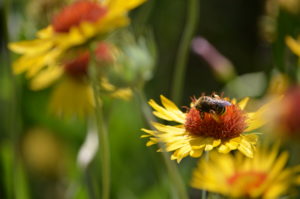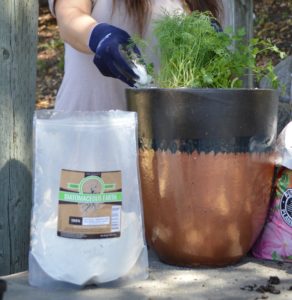Managing Pests
Your garden is a complex biological community that includes good bugs (pollinator and predators) and bad bugs (chewing and sucking insects that may also transmit diseases).
Integrated pest management (IPM) is a process you can use to solve pest problems while minimizing risks to people and the environment. IPM is a sustainable gardening practice that focuses on long-term prevention of pests or their damage through a combination of techniques including prevention, observation, and when necessary, intervention to control significant pest damage. The University of California Statewide Integrated Pest Management Program outlines six basic steps for using IPM:
- Identify the pest.
- Monitor and assess pest numbers and damage.
- Determine when you need to take action.
- Prevent pest problems before they start when and where you can.
- Use a combination of biological, cultural, physical/mechanical and chemical management tools when necessary.
- After action is taken, assess the effectiveness of the controls used.
For the home gardener, IPM is generally the safest and easiest strategy. It means accepting minor bug damage but foregoing combatting every little pest. By using biological controls, cultural controls, mechanical and physical controls, and chemical controls only when necessary, you can in most cases keep your garden healthy while keeping the thugs of the garden world in check.
Biological Controls
Biological controls employ nature’s own forces to battle your garden pests. Predators such as praying mantises, parasites such as parasitic wasps, pathogens such as Bacillus thuringiensis (Bt), and other natural competitors help to maintain a balance in the garden and prevent any single pest from doing significant damage. Here are a few of the hard-working insects and other animals that function as biological controls to keep pest problems under control:
- Ladybugs: Everybody loves ladybugs, but not everyone appreciates the major job they do by eating aphids that suck the juices out of plants.
- Spiders: They may creep us out but the average spider eats about 100 insects a year.
- Toads: Just one toad can help with pest management by eating up to 20,000 slugs, flies, grubs, cutworms, or grasshoppers in a single year.
- Bats: Bats consume large quantities of insects and then do double-duty by acting as important plant pollinators.

- Bees: In California alone, 42 different nut, fruit, vegetable, forage, and seed crops depend specifically on bees for pollination.
- Green lacewings: Green lacewings eat aphids, mites, mealybugs, and other small insects.
- Ground beetles: Ground beetles go after cutworms, grubs, root maggots, slugs, and snails. If you have a log or piece of wood lying around your garden, you’ll often find ground beetles underneath.
- Hover flies: These flies feed on flower nectar, which makes them excellent pollinators. They also eat aphids and mealybugs.
- Hummingbirds: These small birds are not only busy pollinators, they also consume a good many insects as part of their daily diet. See Creating a Hummingbird Habitat.
Cultural Controls
These are the practices you use in the garden that prevent pests from getting established, reproducing, or over-wintering so they can repeat their damaging cycles year after year. These types of controls include limiting fertilizer use to avoid excessive green growth that attracts aphids and other pests and cleaning up fallen fruit and flowers that lead to pests and pathogens lurking in the soil.
Mechanical and Physical Controls
This “hands-on” approach to pest management can refer to a wide range of methods from blasting aphids with the jet spray of a hose to netting fruit trees and berry bushes to prevent birds from beating you to the harvest. Any means of preventing pests from getting onto your plants is a mechanical/physical control and can be very effective with little to no impact on the environment. Common examples include setting sticky traps to kill smaller insects like aphids and whiteflys and spreading diatomaceous earth in order to make the environment unsuitable for their survival.
Diatomaceous earth (DE) is a good barrier for crawling insects. This natural product is made from the fossilized remains of tiny freshwater organisms. Its granular texture has the effect of scraping the undersides of the bugs crawling over it so that they end up dying of dehydration. It is completely safe for pets and edible plants, if you use “food-grade” DE. This is most effective in gardens that do not use sprinklers since wet DE does not work as intended.
Physical controls are also effective at deterring and removing slugs and snails from your garden. Placing copper tape (available at your local nursery or garden center) around the edge of your garden bed or container helps to keep slugs and snails away. If these invertebrates are already present trying offering them a beer – really. Put a shallow pan of beer in the garden at the end of the day and in the morning you’ll find out exactly how many came for the party and never left.
Many bugs such as aphids, scale, and mealybugs become a problem because there is an existing ant problem. Ants basically “farm” these insects for their honeydew secretions. If you control the ants, you will have an easier time controlling the other bugs. One way to keep ants off of fruit trees is to use a product to “trap” them, such as a nondrying, sticky paste that you paint around the base of a tree to keep ants from climbing up.
Chemical Controls
In IPM, chemical pesticides are used when other controls have proved ineffective, in ways that minimize their potential harm to people, other organisms, and the environment. For example, IPM use of chemical pesticides advises baiting traps rather than spraying, or if spraying becomes necessary, to spray in spots rather than over a broad area.
Two commonly used sprays that are considered acceptable for organic gardening are horticultural oils and insecticidal soaps. Horticultural oils, which may be petroleum- or vegetable-based, are sprayed onto plants and coat the insects, effectively smothering them. Different types of oils are used at different times—dormant oils are sprayed on during a plant’s dormant period and summer oils are used in summertime.
Insecticidal soaps are made from potassium fatty acids and are effective against soft-bodied insects like aphids, mites, whiteflies, and mealybugs. The soap works by disrupting cell membranes in the insects, causing them to die, but it leaves most beneficial insects unharmed. It can be toxic for some plants, however, so you may want to test a few leaves to see how the plant reacts before applying more broadly.
When applying any of these controls, be sure to read all of the instructions for application and take the appropriate precautions.